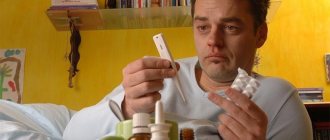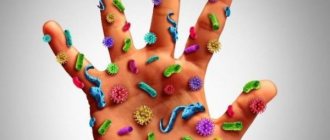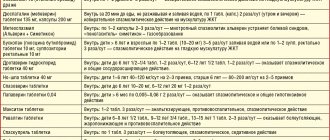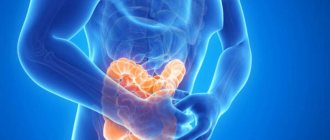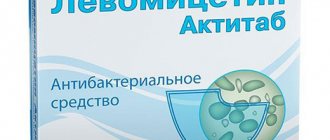What is the difference between poisoning and rotavirus infection
To understand whether poisoning or rotavirus caused intestinal disorders, you need to understand the theoretical differences between one and the other.
Poisoning is a malfunction of organs (and sometimes entire systems) due to the effects of poisons or bacteria that have entered the body, as well as intoxication by waste products of the latter. All this can cause significant harm to the immune system (depending on the cause and severity of the disease).
Rotavirus infection is an acute intestinal viral disease caused directly by rotavirus. The pathogen, once inside, begins to actively multiply, quickly disrupts intestinal function, leads to rapid dehydration and is gradually eliminated from the body during bowel movements.
The popular name for this disease is intestinal flu, the medical name is rotavirus gastroenteritis. The route of infection is oral-fecal, and in a hospital setting or among one group of people where there is a patient or a carrier, there is also a contact-household route.
With rotavirus there is a very high risk of infection between humans and humans, but with food poisoning there cannot be such a threat.
Difference in reasons for development
The difference between poisoning and rotavirus necessarily lies in the causes of each of these problems. Intoxication is caused by bacteria or toxins that enter the intestines. There, microorganisms begin their active life, and poisons are absorbed into the blood and spread to other organs, often affecting entire body systems.
The reason for this is low-quality food products, in the preparation, storage or transportation of which there were gross violations. After eating such products, everyone who ate them will be poisoned, and signs of intoxication will appear in the victims approximately simultaneously (on average after 2 hours).
Rotavirus gastroenteritis is caused by rotavirus that enters the body through contact of a sick person with a healthy person, i.e., the disease, unlike poisoning, is contagious. Transmission of the virus is the main reason for the development of the disease.
Once in the body, the pathogen multiplies very quickly on the inner walls of the intestine (mostly the small intestine). At the same time, the microvilli that line the walls shorten or disappear, and the intestines, so to speak, “go bald,” which leads to failures in the digestion and absorption of food.
Relapses of rotavirus infection are rare, and the immune system is not affected. But the disease in children, especially under 2 years of age, is much more severe than in adults. Rapid and severe dehydration of a small organism is more likely to lead to death, so it is very important to understand the difference between poisoning and rotavirus infection.
Therapy for food poisoning
Typically, poisonings that occur in everyday life are not considered serious illnesses. Even if you do nothing, the symptoms go away after 2-3 days. Therapy is aimed at:
- Elimination of intoxication and removal of pathogenic microorganisms.
- Prevention of dehydration.
- Restoration of intestinal microflora.
- Normalization of the gastrointestinal tract.
If poisoning has serious symptoms, accompanied by severe vomiting, diarrhea, and fever, you must consult a doctor to prescribe appropriate treatment.
We have already discussed how to distinguish poisoning from rotavirus, so it should be obvious that a viral infection requires a more serious attitude and long-term therapy.
Difference in Symptoms
Poisoning and rotavirus in their manifestations have much in common, but at the same time they are significantly different. And the main task of loved ones is to try to understand in time what kind of problem actually exists, especially if there are signs of intestinal disorders in the child.
Signs of rotavirus gastroenteritis
The following symptoms distinguish infection from poisoning:
- excessive dryness of all mucous membranes;
- weight loss per day;
- several days of high temperature from 38 ºC to 39 ºC;
- severe weakness, drowsiness;
- sunken eyes, discharge from them;
- dark urine (in severe cases - with blood);
- sharp pain and gurgling in the abdomen;
- coated tongue;
- refusal to eat;
- frequent severe vomiting;
- in the first days, multiple loose stools (up to 12-20 times a day) of a cheesy, yellowish consistency with greenish inclusions and a characteristic fetid sour odor;
- in the following days, the stool takes on a grayish tint and a consistency similar to clay.
It is vomiting and diarrhea that lead the body to severe dehydration. In addition, rotavirus differs in catarrhal symptoms (which is not the case with poisoning):
- coughing;
- redness of the throat and pain when swallowing;
- runny or stuffy nose.
With proper treatment, the disease goes away in 4 days, maximum - a week.
Signs of rotavirus infection in adults are not always so clear. Sometimes a sick person may not even suspect that he has the virus due to hidden symptoms (one-time diarrhea, a slight decrease in appetite, attributed to fatigue, etc.).
Signs of poisoning
Symptoms of poisoning in adults and children are generally similar, but due to age and differences in immunity, they may differ in severity:
- stomach ache;
- flatulence;
- vomiting, nausea and diarrhea.
These are just the main symptoms that appear in the intestines and indicate food poisoning after eating low-quality foods. When intoxicated with poisons, additional signs are observed:
- fever and chills;
- headache;
- pain in joints and muscles;
- weakness;
- vomiting and nausea;
- visual disturbances;
- disturbances in the functioning of the nervous system and brain functions;
- fainting;
- profuse drooling;
- decreased or increased muscle tone.
Due to vomiting and diarrhea, the body will also become dehydrated, which will lead to the following symptoms:
- severe thirst, dry mucous membranes;
- cold sweat;
- weakness;
- decrease in blood pressure;
- tachycardia;
- rare urination;
- weight loss.
How to distinguish poisoning by additional signs? This is characterized by a temporary decrease in pain in the abdomen after an attack of vomiting, whereas with rotavirus the pain persists.
An important difference between rotavirus infection and any poisoning will be the speed of the initial manifestation of symptoms: in the first case, the incubation period lasts 1-5 days, people gradually become infected from each other “along the chain” after contact. In the second, a single case or a simultaneous group outbreak after the joint consumption of a low-quality product appears within a matter of hours.
In mild cases of poisoning, the problem goes away on its own after 1 or 2 days. But if after this time the symptoms persist or increase, you should immediately consult a doctor.
Rotavirus in a child - symptoms and treatment, distinguish from poisoning
Rotavirus or intestinal flu is not uncommon among children and adults. In order not to treat the symptoms of this unpleasant disease, you should know its main differences from poisoning.
About rotavirus infection
Rotavirus infection is an infectious disease of the digestive system, accompanied by intoxication and lack of fluid in the body.
People of absolutely any age can get sick, but more often children from six months to 3 years old experience intestinal flu.
This is due to the fact that at this time the baby’s body does not have the necessary antibodies, while the baby receives all the protective substances through mother’s milk.
Rotavirus is divided into two types:
- Intestinal.
- Gastrointestinal.
The consequences of rotavirus infection can be:
- hemodynamic disorders;
- acute renal failure;
- convulsions as a result of prolonged hyperthermia in the baby;
- toxic nephropathy;
- uremic-hemolytic syndrome;
- damage to the nervous system (fainting, delirium), as the body’s reaction to toxins;
- necrotizing enterocolitis.
In order not to encounter all the listed complications, if a child experiences vomiting or diarrhea, you should immediately call a doctor.
What is
The causative agent of intestinal flu is reovirus. Only certain types of virus are dangerous for a child. The microorganism consists of outer and inner protein shells, and its genome is made of double-stranded RNA.
The infectious agent is viable for 2-3 months, can withstand the effects of ether and acids, but dies when heated.
Most often, rotavirus occurs in children in winter and spring.
Development mechanism
The virus carrier introduces the virus into the external environment along with feces. A child can become infected in a group of children or through their own parents infected with rotavirus.
After the infection enters the body, it invades the cells of the mucous membrane of the digestive tract (usually the small intestine). Once in them, the rotavirus rejects their villi.
Mature cells are replaced by shapeless structures that are not able to reproduce the enzymes necessary for digestion, digest and absorb. Thus, rotavirus does not irritate the gastrointestinal tract, but disrupts digestive functions.
A lack of maltase, lactase and invertase leads to the accumulation of unbroken sugars in the intestines. Then the child develops secretory diarrhea, leading to dehydration.
The infection can be transmitted in the following ways:
- fecal-oral;
- with food;
- with water;
- through household items;
- airborne (extremely rare).
In the youngest children, the infection enters the body through the mouth. They learn to crawl, pull various objects into their mouths, suck their fists, and touch pieces of furniture that may contain dust with pathogenic microorganisms.
More often, infection occurs through household items. If, after using the toilet, hands are not washed enough and a person touches the door handle, then an infection remains on it, which is easily transmitted to the child and other family members.
Children often get sick at seaside recreation centers. There, the infection is transmitted through dirty water or sand. Kindergartens, schools, clinics and hospitals are also no exceptions. Since any crowded places are unsafe for children and parents in terms of communication and tactile contact.
How to treat rotavirus in infants
Immunity to rotavirus develops at an early age after infection. But with a decrease in immunity, re-infection is possible at a later age.
How to recognize rotavirus infection
How to distinguish rotavirus from poisoning? To do this you need to know its characteristic symptoms. Rotavirus infection has a cyclical course. The period from the moment of infection to the appearance of the first signs lasts 1-4 days, but more often than not more than a day. Micronism is resistant to chlorine-containing drugs and tolerates low temperatures well.
https://www.youtube.com/watch?v=GegeezZLnNQ
The first symptom of rotavirus in adults and children is body hyperthermia (38-40 degrees). Then the child experiences spasmodic pain and gurgling in the abdomen, which is gradually joined by loose stools and repeated vomiting. Moreover, the last two symptoms do not depend on the amount of food consumed. The volume of excreted masses exceeds the food and water received by the child.
Respiratory symptoms of rotavirus infection include runny nose, cough, inflammation, and redness of the throat.
It is extremely difficult to bring down the temperature with rotavirus infection. It can stay at 39 degrees for 5-6 days. Infants, among other symptoms, experience:
- severe weight loss;
- lethargy;
- drowsiness.
As the infection progresses, the child develops exicosis (dehydration). Stages 1 and 2 of this disorder are characterized by pale skin, lethargy and thirst. In its extreme form, dehydration is accompanied by hoarseness, involuntary muscle contractions and decreased diaresis.
These symptoms indicate severe dehydration:
- constant thirst;
- sunken eyes and anterior fontanel;
- drying of the skin and mucous membranes in the body;
- earthy gray skin tone;
- bright and dry lips;
- decreased skin elasticity;
- decreased urine output.
The subacute form of intestinal flu also poses a danger to the child. With it, he observes:
- decreased appetite;
- moodiness;
- lethargy;
- fatigue;
- migraine;
- rumbling in the stomach;
- sore throat;
- nasal congestion;
- enlarged lymph nodes in the neck;
- not a strong cough.
Doctors often confuse symptoms of insufficient rotavirus infection with acute respiratory viral infections and acute respiratory infections. This condition usually lasts 3-4 days.
The main difference between diarrhea during intestinal flu and salmonellosis and dysentery is the absence of mucus, blood and green clots in the stool. Also, with rotavirus, the child does not experience a tormenting false urge to defecate. In infants with infection, stool may lose its color but remain thick.
Diarrhea due to rotavirus infection lasts on average 5-6 days. The first few days the stool has a watery consistency, and then becomes clay-like and acquires a gray-yellow color.
The presence of blood impurities in the stool indicates the addition of a bacterial infection to the rotavirus.
How to distinguish rotavirus from ordinary poisoning? The main difference is that in case of poisoning, the child experiences relief after vomiting. With an intestinal infection, there is no relief.
Therefore, if the disease strikes a child who already knows how to talk, then recognizing the true cause of the unpleasant symptoms is much easier.
Diagnostic features
At first glance, rotavirus can easily be confused with poisoning. But it can be distinguished by some features characteristic only of this disease:
- Autumn-winter seasonality of pathology among children from 1 to 3 years old.
- The disease develops suddenly and rapidly (severe hyperthermia, vomiting and secretory diarrhea).
- From the first day of infection, a combination of respiratory and gastroenteritis scatological syndrome is observed.
- There is no mucus, greens or blood in the stool.
- Absence of pathogen during standard bacteriological examination.
If all of the signs are present, the doctor prescribes treatment for rotavirus based on the key symptoms.
Laboratory diagnostics
Laboratory tests help identify the causative agent of the disease and dismiss the poisoning version. Blood, feces and urine are taken from a small patient for analysis:
- Virological examination of stool and virus isolation in cell cultures.
- Serological studies using ELISA, RN, RSK, RNGA, latex agglutination methods.
If inaccurate test results are obtained or in case of suspected interference with rotavirus infection, retromanoscopy with aspiration biopsy of the colon mucosa is used.
What can be confused with
When conducting diagnostics to prescribe treatment, doctors must exclude options for infecting a child with dysentery, salmonellosis, cholera, yersiniosis, and protozoal intestinal invasions.
First aid for rotavirus infection
At the first signs of illness, you need to provide the child with all the necessary help. Then hospitalization will most likely not be required and the baby will be able to be treated at home.
- Call a local doctor or children's emergency room. If a child has almost all the signs of grade 1-2 rotavirus, then it is better to treat at home, without hospitalization in an infectious diseases hospital. But it is important to evaluate the parents’ capabilities in maintaining the proper level of fluid in the baby’s body.
- Prepare burp containers and a sufficient number of towels.
- Purchase of all necessary medications (No-Shpa, Regidron, dosage syringes with water, antipyretic drugs).
After preparing for treatment, parents should strictly follow the doctor's instructions.
Treatment of rotavirus infection
How to treat rotavirus in adults and children? During treatment, all efforts of doctors are primarily aimed at eliminating such unpleasant symptoms as intoxication, dehydration, problems in the circulatory and excretory systems. The child is hospitalized only in the most severe cases. In mild and moderate forms of the disease, treatment is carried out on an outpatient basis.
When prescribing appropriate treatment, the level of dehydration of the child’s body plays a key role. In the case of grades 1 and 2, the water-salt composition of the blood is returned to normal (Regidron, Gluxonal, etc.). Small doses of the solution are prescribed to the patient for 13 days until the stool is completely normalized.
For grade 3 dehydration, intravenous injections are used. In the most severe cases, doctors prescribe Reosorbilact, Hemodez and other macrodextrants.
In the acute form of the disease, astringent and adsorbent substances (Smecta, Enterosgel, etc.) are used to quickly remove the virus from the body. These medications are given to the child for 3 days in accordance with the instructions.
Since many children with rotavirus infection develop intestinal dysbiosis, complex treatment includes biological preparations with lactobacilli (Lactobacterin, Acylact, etc.). And to increase the number of antibodies, anti-rotavirus immunoglobulin or a complex immunoglobulin medication is indicated.
After the cessation of gagging, normalization of the frequency of bowel movements and a decrease in body temperature, the child should be given enzyme preparations that normalize digestion (Festal, Mezim-Forte, etc.) for 10 days.
Medicines contraindicated for treatment
But not all drugs for unpleasant symptoms treat rotavirus infection. First of all, the prescribed funds should be aimed at improving the child’s condition and reducing the frequency of going to the toilet.
Taking antibiotics is useless for rotavirus infection. In addition, they can aggravate the situation, as they impair the digestion of food.
Diet for rotavirus
Diet plays an important role in the treatment of rotavirus in adults and children. Many enzymes lose their activity during the development of the disease. Therefore, the following should be excluded from the child’s diet:
- dairy products;
- sweet fruits;
- cucumbers and tomatoes;
- fruit juices;
- baking;
- legumes;
- meat;
- butter and vegetable oil;
- broths;
- meat products;
- fatty and fried foods.
The child should often eat in small portions, and be sure to include slimy porridges, soups, vegetable purees, jelly, white bread croutons and oven-baked apples in the diet.
If the baby is breastfed during the infection, then under no circumstances should it be stopped.
Fluids during diarrhea and vomiting should be replenished constantly. You need to drink slowly and in small sips, taking ten-minute breaks.
In the case of rotavirus in an infant, after vomiting he should be given 50 ml of liquid, and a baby older than one year should be given 100-200 ml. If dehydration is very serious, then compliance with the drinking regime is prescribed by the attending physician.
You can drink non-carbonated mineral water, weak tea, lemon water, fruit juice and specialized saline solutions.
Prevention of intestinal infection
To prevent possible infection of a child with rotavirus infection and subsequent severe treatment, certain preventive measures should be followed. They are quite easy to remember:
- Drink only boiled water.
- Wash vegetables and fruits with a brush.
- It is sufficient to heat-treat food products first.
- Wash your hands before eating or touching your baby.
It is also very important to treat the disease from the moment the first symptoms appear.
An intestinal infection in a child should be treated following the doctor’s recommendations in order to prevent the terrible consequences of the disease. And to prevent its relapse, all preventive measures should be followed.
(1 5,00 of 5) Loading...
Source: https://supermams.ru/rotavirus-u-rebenka.htm
Differences in treatment
It is very important to distinguish rotavirus infection from intoxication, because in their treatment there will also be similarities and significant differences:
- In case of intoxication, it is necessary to give an enema or rinse the victim’s stomach by drinking plenty of fluids and artificially inducing vomiting until the waters are clear. But one point is important here: for poisoned children under 2 years old, independent gastric lavage and provoking vomiting are contraindicated! For rotavirus infection, the procedure is useless, since the pathogen “operates” directly in the intestines.
- For food poisoning, after successful washing, sorbents are used to remove toxins: activated carbon, Enterosgel, etc., plus drugs that stop uncontrollable diarrhea. In the treatment of rotavirus infection, diarrhea is not always stopped, since the virus is eliminated from the body through feces, but in some cases antidiarrheals (Enterol, Stopdiar, etc.) can be prescribed.
- The heat caused by intoxication can be brought down. Rotavirus dies at temperatures above 38 ºC, so it can be reduced only at 38.5 ºC or in young children with intolerance to hyperthermia.
- For abdominal pain during intoxication, take painkillers (No-Shpa, Revalgin, etc.). For viral gastroenteritis - at the discretion of the attending physician.
Regarding medications, there is another very significant difference: viral infections are never treated with antibiotics under any circumstances! Despite their power, antibacterial drugs do not fight viruses and in this case will be useless. They can be prescribed for bacterial poisoning, but rotavirus is treated accordingly with antiviral agents.
General points in treatment
In both cases, fluid loss occurs in the body, so procedures aimed at replenishing it are vital.
For rehydration, droppers or solutions of Regidron, Gidrovit, Trihydron are prescribed for oral administration. But at the same time, no one canceled the importance of additional drinking - clean drinking water or sweetened tea. It is important to know what to do if you suspect rotavirus in children under 2 years of age. The process of dehydration in them occurs much more rapidly than in adults, so the child needs to drink a spoon every 5 minutes, despite vomiting.
After the cessation of vomiting and diarrhea in case of intoxication and rotavirus, drugs are included that restore the intestinal microflora (Linex, Hilak Forte, Bifidumbacterin, etc.). The damaged intestines are in dire need of help, and these remedies will provide it gently and carefully.
What do you have?
Rotavirus or poisoning are similar in many ways, and hoping for chance, people do not always rush to call a doctor. Due to late treatment, the number of deaths from dehydration caused by both intoxication and the virus has increased significantly in recent years. And it’s especially scary that children are the first to suffer here. Therefore, the very first symptoms should be the impetus for calling specialists in order to avoid really very serious problems.




